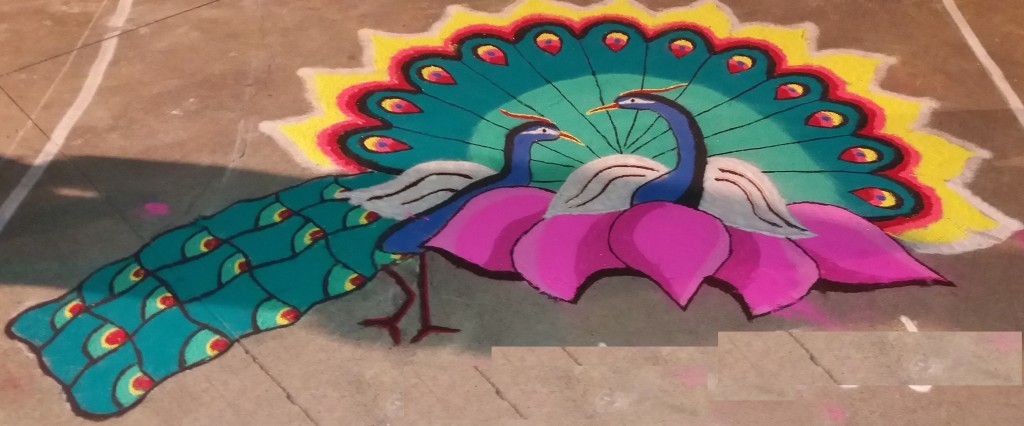Why do Indians make Rangolis?

Peacocks are a popular rangoli theme. By the time I managed to grab a photo of this rangoli someone had walked on it causing the colors to mix.
A rangoli is a beautiful design made with colors. Rangolis are made on special occasions like weddings, Diwali or Navratri. Beautiful designs and motifs are made on the floors using powders of various colors. The lovely combination of colors and the geometric patterns make rangoli a marvelous piece of art.
Why do Hindus make rangolis?
A rangoli is essentially a sign of welcome. The purpose of making rangolis on occasions like Diwali is to welcome Goddess Lakshmi into one’s home. Rangolis also ward off the evil eye.
Rangoli is basically a Maharashtrian art, but now it is practiced all over India. In South India, it is called ‘Kolam’. Actually, a Kolam uses just one color – white. It is made with rice powder. Other colors are not normally used. Rangolis that you find in Maharashtra and other parts of North India are colorful.
Rangolis are typically made by women. The designs are passed down through generations. They are geometric and proportioned.

A rangoli made on a busy road – rangolis are usually made on the floor in front of one’s door. Should the situation arise they are also made in the middle of busy roads. This is a scene from Mumbai.
Rangoli patterns are made with fingers using crushed chalk of various colors and rice powder. Sometimes these patterns are topped with flowers, grains or pulses. Since the purpose of making rangolis is to welcome Goddess Lakshmi into the home, small footprints coming towards the home are also drawn. Rangolis come in various sizes. While some rangolis cover an entire room, others may be the size of a doormat.

A rangoli design inspired by the peacock – this rangoli won the first prize in the rangoli competition organized by our housing society.
The overall beauty of a rangoli depends upon the skills of the maker. Rangolis are always drawn with fingers. The mapping is done with dots. These dots are then connected to make a pattern. Once the pattern is ready, it is filled with colors. There should be no broken lines in the pattern. If there are gaps in the lines, evil spirits may enter through them.
A rangoli is a temporary design made to last one day. During festivals a new pattern is made every day. Certain designs are created on special occasions such as weddings and religious festivals like Diwali.
Rangoli Decoration Themes
Most rangoli designs are based on themes that have been in use for centuries. Common themes include symbols like the sun, moon, stars, holy symbols like Om, Swastika, Chakra, Mangal Kalash, lotus etc. Flowers, plants, leaves, trees, birds, elephants and geometrical figures like circles, triangles, semi-circles, squares and rectangles are also common. During Diwali most Indian homes have a rangoli drawn at the entrance door.

A flower rangoli – flower rangolis (pookkalam) are made by Malayalis during Onam, the biggest festival in the South Indian state of Kerala.
The beauty of a rangoli depends upon the skills of its maker. This is an art. During special occasions like Diwali, rangoli making competitions are organized all over the country.
Rangoli colors
The colors used to make a rangoli come from various substances. In the olden days, the colors were derived from natural dyes. Today synthetic colors are used because of their easy availability. Also synthetic colors are available in a range of hues. Finely ground rice flour is used for the color white. A pinch of the powder is taken and applied with the forefinger and thumb. Nowadays the rice flour is being replaced by white stone powder.
In the South Indian state of Kerala, rangolis are made with flowers. Actually flower rangolis are made on the floor on all ten days of the Onam festival. They aren’t made on other occasions.
It is not easy to make a rangoli. It is a laborious process that requires a great deal of time and expertise. Still these beautiful patterns are made on all special occasions for several reasons. This is a traditional Indian art that reflects our culture. It creates harmony and positivity – a beautiful rangoli instantly cheers up everyone. It is inviting – the rangoli is a symbol of our hospitality. It seeks perfection in art and shows our deep-rooted reverence for the divine.